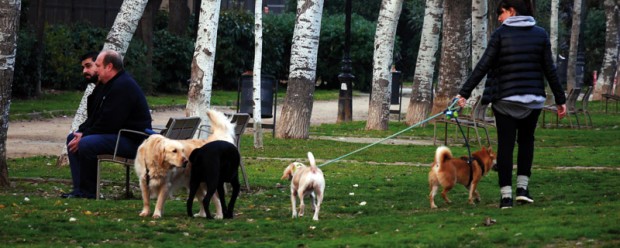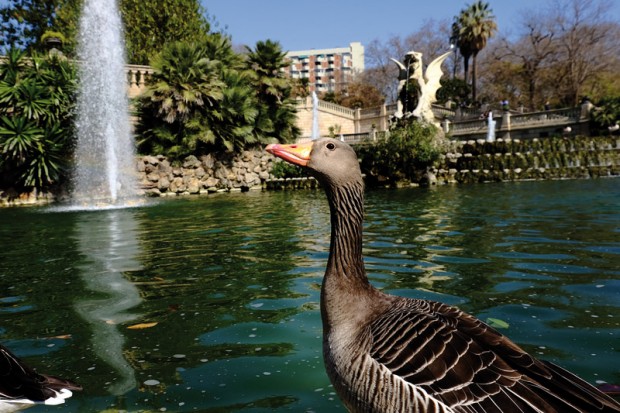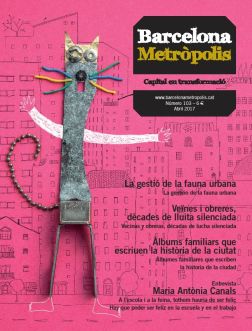Urban wildlife and vegetation are not simply a reminder of the natural environment, with which we have an emotional attachment. We also have an obligation to care for them, if we want to contribute effectively to the creation of a functional city, connected to natural cycles and providing a habitable public space.

Barcelona’s green spaces and biodiversity plan has emerged as the strategic framework for recovering the city’s nature. The plan aims to expand and improve green areas and to make the city more animal-friendly. In the photo, people and dogs share the public space in Ciutadella Park for a late-afternoon walk.
Photo: Vicente Zambrano
It’s breakfast time; a pair of Sardinian warblers and another of greenfinches are scavenging in the little urban vegetable garden on the terrace, while a bee buzzes around. Every now and then, they are joined by a black redstart, with its trademark fiery orange tail. The squawks and nimble flight of the swifts that return to the city each year herald the coming of spring (whereas summer is on its way when the lime trees blossom, their tiny flowers filling the Rambla de Catalunya with their sweet, potent fragrance). Every day, en route to the metro, a white wagtail, a pair of blackbirds and a few collared doves make timid forays onto the pavement from the University gardens.
In the evening, a group of neighbours meets in the street while walking their dogs. Parakeets, pigeons and magpies busy themselves in the lush medlar tree, watered lovingly by a resident every weekend. The seagulls watch it all from the rooftops. When night falls, a group of grey herons, in perfect straight-line formation, crosses the horizon on its way back to the Llobregat delta, or perhaps to Barcelona Zoo, where a large colony of them lives. Sometimes, as silence falls, broken only by the barking of Max, the neighbour’s dog, one can catch a glimpse of the elegant flight of the peregrine falcon, reintroduced into the city a decade ago thanks to the work of a group of residents.
These daily brushes with Barcelona’s wildlife, which lives alongside our domestic animals, are neither a piece of fiction nor a laboured attempt to emulate Gerald Durrell’s childhood on Corfu. It’s the true story of the everyday encounters of a Barcelona resident who finds these moments of restfulness and well-being thanks to the urban flora and fauna. And this is, in fact, one of the primary functions of urban biodiversity: health, enjoyment and well-being. Collective health and well-being as well as of the people who share their home with animals.
Cities are like a great storm drain of matter and energy, and they generate an output (waste, air and water pollution, noise…). Our growing need for energy and materials means that urban life is leaving an ever more pronounced and far-reaching footprint. Right now, humankind is consuming 52 per cent more each year than nature is able to replace over the same time frame. Since 1970, we have exceeded nature’s biocapacity to provide us with the products and services it offers. Since 1970, 30 per cent of the world’s biodiversity has been lost and many natural ecosystems have shrunk.
As city dwellers, we must help to staunch this outflow by, on the one hand, changing our production and consumption model, using fewer materials, stop wasting food, recycling, reducing our waste, using public transport, generating renewable energy, using energy in our buildings more efficiently; and, on the other, by drastically overhauling the way we evaluate, promote and preserve our urban biodiversity. Urban fauna and flora are not just a reminder of the natural environment, with which we have an emotional attachment. We also have an obligation to care for them, if we want to contribute effectively to the creation of a functional city, connected to natural cycles and that provides a habitable public space for us to share.

Aquatic species in Ciutadella Park’s pond, just one example of fauna perfectly adapted to urban life.
Photo: Vicente Zambrano
Social and environmental quality
A city is not just a jumble of buildings, services and economic opportunities. It’s also the air we breathe, the water we drink, the space we live in. So we must call for it to be a place with healthy air and water, with a biodiverse and equitable public space that fosters contact and deliberation. The opportunities that the city provides us with cannot be disconnected from the environmental and social quality of the space. We must make Barcelona a more equitable, more efficient, more diverse and less polluted city. Urban wildlife is an excellent indicator of this necessary change.
Nature in the city also has tangible benefits. It provides ecosystem services: reducing the heat island, neutralising contaminants and carbon dioxide, building resilience, and so on. The first issue, then, is to improve and increase the quantity and quality of green spaces where urban wildlife can prosper. The richer and more diverse our urban flora and fauna, the more habitable our city will be.
The green spaces and biodiversity plan is the strategic framework for this recovery of the city’s nature. It is not easy to expand green space in a city as dense as Barcelona. One has to use every available surface. Developing the city’s natural environment means extending the surface area of green spaces (new hubs and corridors), but above all it means increasing the functional green space, the vegetation cover and the quality and diversity of species, which is what the tree plan sets out to do. We also need to make use of roof terraces, façades and squares. We should be bringing provisional greenery to spaces destined for other purposes until they come into use. We need to let the public decide and manage this process to redevelop nature. We need to promote urban agriculture.
Since January 2017, the use of glyphosate to treat green spaces has been banned and this is also a step in the right direction: it will change the appearance of the city as we know it and bring tree surrounds and flowerbeds that are teeming with life. It will create a green network connecting Collserola, the city’s great reservoir of biodiversity, to the coast.
Ethical management of urban fauna
At the same time as increasing green spaces and building an animal-friendly city, we also need to move forward in terms of ethical population management and improving coexistence. Some species adapt to the urban habitat so well that they can threaten the well-being of other species, disrupt the convenience of living in the city or have a harmful effect on the green and built environment and even on our health. Some species have adapted so well for so many years that they are as urbanite as we are. Others, arrived from faraway lands, have settled here more recently. Some of them have been cautious neighbours, venturing gradually further into urban areas. When this happens, these populations have to be managed. The challenge is to do so ethically and from a preventive standpoint.
While it is essential to respect, value and ethically manage our urban wildlife, we face another fundamental challenge: living together. Key is the responsible ownership of animals, as is the understanding that animals are not objects but living beings; that pet owners are responsible for ensuring that the public space is shared harmoniously; that having city animals must not be taken lightly – they are friends for life; that abandoning them is a crime; and that it’s better to adopt (the Pets’ Reception Centre (CAACB) rehomes hundreds of cats and dogs every year). As well as responsible ownership, the city must also provide spaces and facilities to help care for the city’s animals; such as, for example, the ten new dog recreation spaces planned for 2018, and the 695 cat colonies managed by charities.
Ultimately, urban fauna and biodiversity are the instruments and indicators of health, habitability, coexistence, well-being, civility and environmental commitment. The challenges are to look after them, strengthen them, publicise them, manage them ethically and develop an urban model that enables us all to enjoy them.




Bon dia! M ha agradat molt L article. Jo visc en un edifici de 9 plantes a balmes cantonada travessera de Gràcia i el terrat de la finca no crec q s utilitzi per res. Hi ha algun pla per incentivar fer un terrat verd o posar plaques solars… Ser una mica més sostenible? També a nivell econòmic per plantejar ho a una reunió de veïns…
Gracies
Natàlia